Table of Contents
Tangents to a Circle:
You know that if a line intersects a circle at two coincident points, then the line is called a tangent to the circle at the point of contact.
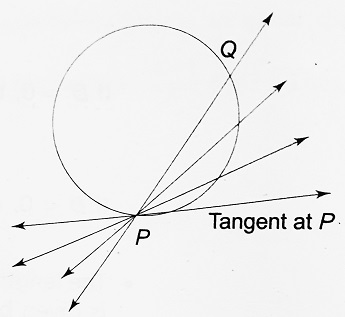
In the figure, the line PQ intersects the circle at P and Q. If the line PQ is now rotated about P in the clockwise direction as shown in the figure, then ultimately a position is reached when Q coincides with P. At this stage, the line becomes tangent to the circle at P. The point P is known as the point of tangency or the point of contact.
Equation of the Tangent to the Circle x2 + y2 = r2 at (x1, y1):
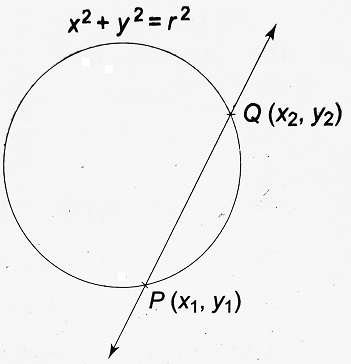
| Let P be the point (x1, y1) on the circle x2 + y2 = r2. We take a neighboring point Q (x2, y2) on the circle as shown in figure. Thus, x12 + y12 = r2 ……….(i) and x22 + y22 = r2 ……….(ii) Equation to PQ is, y – y1 = [ (y2 – y1) / (x2 – x1) ] (x – x1) ……….(iii) From (i) and (ii), we get x22 – x12 + y22 – y12 = 0 ⇒ (x2 + x1) (x2 – x1) = – (y2 + y1) (y2 – y1) ⇒ (y2 – y1) / (x2 – x1) = – (x1 + x2) / (y1 + y2) ∴ Equation to PQ becomes, y – y1 = – [ (x1 + x2) / (y1 + y2) ] (x – x1) As Q → P, x2 → x1, and y2 → y2, and the line PQ becomes a tangent to the circle at P. Thus, the equation to the tangent to the circle x2 + y2 = r2 at P is y – y1 = – (2x1/2y1) (x – x1) ⇒ x1 (x – x1) + y1 (y – y1) = 0 ⇒ xx1 + yy1 = x21 + y21 = r2 (∵ x2 + y2 = r2) |
Equation of the Tangent to the Circle x2 + y2 + 2gx + 2fy + c= 0 at the point (x1, y1):
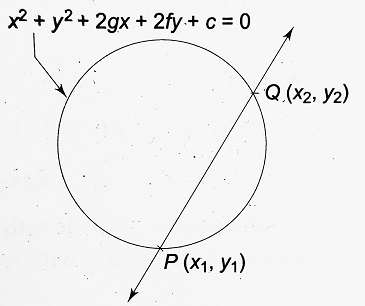
| Let P be the point (x1, y1) on the circle x2 + y2 + 2gx + 2fy + c= 0. We take a neighboring point Q (x2, y2) on the circle as shown in the figure. As P and Q lie on the circle, we have x12 + y12 + 2gx1 + 2fy1 + c= 0 …………(i) and x22 + y22 + 2gx2 + 2fy2 + c= 0 …………(ii) ∴ Subtracting (i) from (ii), we get (x22 – x12) + (y22 – y12) + 2g (x2 – x1) + 2f (y2 – y1) = 0 ⇒ (x2 – x1) (x1 + x2) + (y2 – y1) (y1 + y2) + 2g (x2 – x1) + 2f (y2 – y1) = 0 ⇒ (y2 – y1) / (x2 – x1) = – (x1 + x2 + 2g) / (y1 + y2 + 2f) …………(iii) Now, equation to PQ is y – y1 = [ (y2 – y1) / (x2 – x1) ] (x – x1) ⇒ y – y1 = [ – (x1 + x2 + 2g) / (y1 + y2 + 2f) ] (x – x1) from (iii) As Q → P, x2 → x2 and y2 → y1 and PQ become tangent to the circle at P. The equation of the tangent then becomes. y – y1 = [ – { 2 (x1 + g) } / { 2 (y1 + f) } ] (x – x1) ⇒ (y – y1) (y1 + f) = – (x – x1) (x1 + g) ⇒ yy1 + fy – y12 – fy1 = – (xx1 + gx – x12 – gx1) ⇒ xx1 + yy1 + gx + fy = x12 + y12 + gx1 + fy1 Adding (gx1 + fy1 + c) on both sides, we get xx1 + yy1 + g (x + x1) + f (y + y1) + c = x12 + y12 + 2gx1 + 2fy1 + c = 0 Thus, the equation of the tangent to the circle x2 + y2 + 2gx + 2fy + c = 0 at (x1, y1) is xx1 + yy1 + g (x + x1) + f (y + y1) + c = 0 Note: The equation of the tangent to a curve at a point (x1, y1) may be obtained from the equation of the curve replacing x2 by xx1, y2 by yy1, x by (1/2) (x + x1), y by (1/2) (y + y1) and retaining the constant terms. |
Length of the Tangent from an External Point:
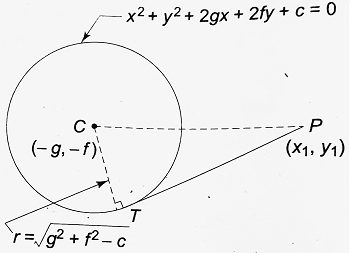
| Let x2 + y2 + 2gx + 2fy + c = 0 be a circle and let P (x1, y1) be a point lying outside the circle. PT is tangent to the circle through P. Obviously, CT is the radius of the circle, and ∠CTP = 90°. The coordinates of C are (-g, -f) as shown in the figure. In the right triangle CTP, CP2 = PT2 + CT2 ∴ PT2 = CP2 – CT2 ⇒ PT2 = (x1 + g)2 + (y1 + f)2 – [ √(g2 + f2 – c) ]2 ⇒ PT2 = x12 + 2gx1 + g2 + y12 + 2fy1 + f2 – g2 – f2 + c = 0 ⇒ PT2 = x12 + y12 + 2gx1 + 2fy1 + c ∴ PT =√( x12 + y12 + 2gx1 + 2fy1 + c) Note: If S = 0 be a circle. Then, the length of the tangent drawn from an external point (x1, y1) is given by √S1, where S1 is the value of S obtained by putting x = x1, y = y1. PT2 = x12 + y12 + 2gx1 + 2fy1 + c The square of the length of the tangent drawn from an external point P (x1, y1) is called the power of point P with respect to the circle under consideration. |
| Example 1: Find the equation of tangent to the circle x2 + y2 – 2x – 10y + 1 = 0 at (-3, -2). Solution- Equation of a tangent to the circle x2 + y2 – 2x – 10y + 1 = 0 at (-3, -2) is- x (-3) + y (-2) – 2 [ {x + (-3)} / 2 ] – 10 [ {y + (-2)} / 2 ] + 1 = 0 ⇒ -3x – 2y – x + 3 – 5y + 10 + 1 = 0 ⇒ -4x – 7y + 14 = 0 ⇒ 4x + 7y – 14 = 0 |
| Example 2: Find the equations of tangents to the circle x2 + y2 – 6x + 4y – 12 = 0 which are parallel to the line 4x + 3y + 5 = 0. Solution- Let the equation of tangent parallel to the line 4x + 3y + 5 = 0 be 4x + 3y + k = 0 ………..(i) Now, the equation of a circle is- x2 + y2 – 6x + 4y – 12 = 0 Here, the center (3, -2) and radius (r) = √[32 + 22 – (-12) ] ⇒ r = √(13 + 12) = √25 = 5 Since the line (i) is tangent to the circle, therefore the distance of the line (i) from the center (3, -2) of the circle is equal to the radius of the circle. ⇒ | 4(3) + 3(-2) + k | / √[ (4)2 + (3)2 ] = 5 ⇒ | 6 + k | / 5 = 5 ⇒ | 6 + k | = 25 ⇒ 6 + k = ± 25 ⇒ 6 + k = 25 or 6 + k = -25 ⇒ k = 19 or k = -31 ∴ The required equation of tangent is, 4x + 3y + 19 = 0 and 4x + 3y – 31 = 0 |
| Example 3- The line 4x – 3y + 12 = 0 is a tangent at (-3, 0), and the line 3x + 4y = 16 is a tangent at (4, 1) to the circle. Find the equation of the circle. Solution- The equation of the tangent at (-3, 0) to the circle is, 4x – 3y + 12 = 0 ∴ The equation of Normal at (-3, 0) is- 3x + 4y + k = 0 ……….(i) Now (i) passes through (-3, 0) ∴ 3(-3) + 4(0) + k = 0 ⇒ k = 9 Equation (i) becomes- 3x + 4y + 9 = 0 ……….(a) Now equation of the tangent at (4, 1) to the circle is, 3x + 4y – 16 = 0 ∴ The equation of Normal at (4, 1) is- 4x – 3y + λ = 0 ……….(ii) Now (ii) passes through (4, 1) ∴ 4(4) – 3(1) + λ = 0 ⇒ 16 – 3 + λ = 0 ⇒ λ = -13 Equation (ii) becomes- 4x – 3y -13 = 0 ……….(b) Equations (a) and (b) represent the equation of the diameter of a circle which one solving gives the center of the circle. Solving (a) and (b), x / (-52 + 27) = y / (36 + 39) = 1 / (-9 – 16) ⇒ x/-25 = y/75 = 1/-25 ⇒ x = 1, y = -3 ∴ Coordinates of the center of the circle are (1, -3) Now, Radius = Distance between points (1, -3) and (-3, 0) ⇒ r = √ [ (-3 -1)2 + (0 + 3)2 ⇒ r = √(16 + 9) = √25 = 5 Thus, the equation of the circle is, (x – 1)2 + [y – (-3)]2 = (5)2 ⇒ x2 + 1 – 2x + y2 + 9 + 6y = 25 ⇒ x2 + y2 – 2x + 6y – 15 = 0 |
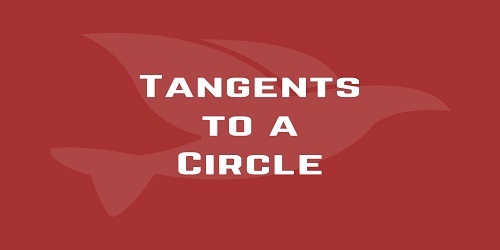
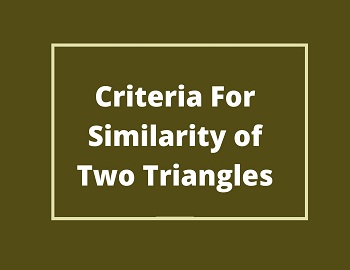

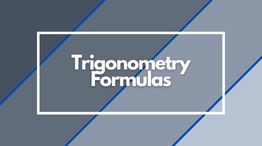
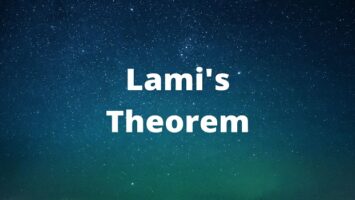
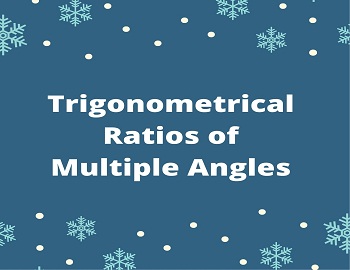
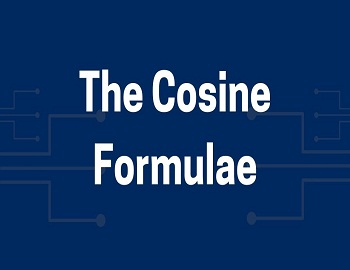
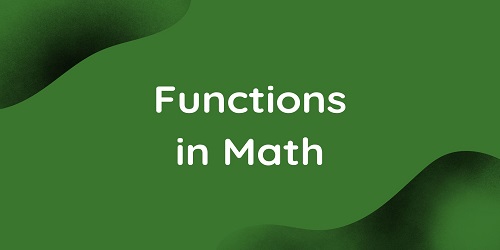

Comments (No)